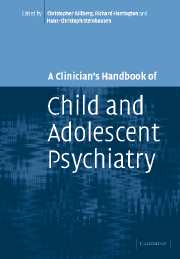Book contents
- Frontmatter
- Contents
- Preface
- List of contributors
- 1 Brain disorders
- 2 Substance use disorders
- 3 Schizophrenia and schizophrenia-like disorders
- 4 Affective disorders
- 5 Anxiety disorders
- 6 Obsessive-compulsive disorders
- 7 Adjustment disorders
- 8 Post-traumatic stress disorder
- 9 Functional somatic symptoms and somatoform disorders in children
- 10 Eating disorders: anorexia nervosa and bulimia nervosa
- 11 Sleep disorders
- 12 Personality disorders
- 13 Mental retardation/learning disability
- 14 Specific developmental disorders of speech and language
- 15 Reading and other learning disorders
- 16 Autism spectrum disorders
- 17 Hyperkinetic disorders
- 18 Conduct disorders
- 19 Elective mutism
- 20 Attachment and disorders of attachment
- 21 Tic disorders
- 22 Elimination disorders: enuresis and encopresis
- 23 Physical and sexual abuse
- 24 Gender identity disorders
- Index
- References
21 - Tic disorders
Published online by Cambridge University Press: 06 August 2009
- Frontmatter
- Contents
- Preface
- List of contributors
- 1 Brain disorders
- 2 Substance use disorders
- 3 Schizophrenia and schizophrenia-like disorders
- 4 Affective disorders
- 5 Anxiety disorders
- 6 Obsessive-compulsive disorders
- 7 Adjustment disorders
- 8 Post-traumatic stress disorder
- 9 Functional somatic symptoms and somatoform disorders in children
- 10 Eating disorders: anorexia nervosa and bulimia nervosa
- 11 Sleep disorders
- 12 Personality disorders
- 13 Mental retardation/learning disability
- 14 Specific developmental disorders of speech and language
- 15 Reading and other learning disorders
- 16 Autism spectrum disorders
- 17 Hyperkinetic disorders
- 18 Conduct disorders
- 19 Elective mutism
- 20 Attachment and disorders of attachment
- 21 Tic disorders
- 22 Elimination disorders: enuresis and encopresis
- 23 Physical and sexual abuse
- 24 Gender identity disorders
- Index
- References
Summary
Introduction
Usually, tic disorders have their onset around school entry and in many cases they develop into a complex neuropsychiatric disorder with a high variety of associated problems. Only about 15 per cent of cases remain with their tics only. On the other hand, there is a tendency of spontaneous remission of tics after adolescence. Hence, refined developmental psychopathological knowledge is necessary to diagnose and treat the patients in an adequate manner.
The interaction of tic expression with stress sensitivity and tic awareness is another point of practical relevance. Although the background of tic disorders has been the subject of ignorance and speculations for at least the past 300 years, today we accept genetic, neurodynamic and psychological factors as well as their interplay. All of these have to be assessed in each individual case concerning tic control.
Finally, knowledge of the short-term and long-term spontaneous temporal patterning of tics is important for the clinician, because it informs decisions about when to initiate anti-tic interventions, when to change drugs and when to be patient and simply provide close monitoring and support to the family to cope with the psychosocial problems.
Definition and classification
The main features of tic disorders are:
motor and/or vocal tics (see Table 21.1)
begin in proximal areas (head, face, neck)
occurrence of tics many times a day (every day or intermittently; waxing and waning)
duration of tics from 4 weeks to more than 1 year
suppressibility of some tics for a short period of time (after the age of 10 years)
premonitory sensorimotor sensations before tics (after the age of 10 years)
[…]
- Type
- Chapter
- Information
- A Clinician's Handbook of Child and Adolescent Psychiatry , pp. 598 - 624Publisher: Cambridge University PressPrint publication year: 2006
References
- 9
- Cited by



